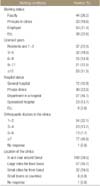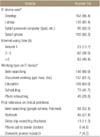Abstract
Purpose
Awareness on continuing medical education (CME) of the Korean Orthopaedic Association (KOA) was investigated in order to augment the weak educational points of the conventional academic CME.
Materials and Methods
The web-survey was conducted in the KOA on the awareness of conventional academic or web-based CME. The questionnaire included working conditions, intimacy of informational technology, and strengths and weaknesses of academic and web-based CME.
Results
Among 3,427 emails sent, 168 (4.9% of effective response rate) responses were received. Of the responders, 74.4% of the responders could not attend CME frequently because of working time (35.7%) and a distance far from the working place (13.2%). The merits of academic CME included as the opportunity for considerations of other members' thoughts on some clinical matters (64.3%); however, the weak points were holding several similar conferences (60.1%) and too short time for adequate study (53.0%). They wanted that surgical procedures and tips (49.0%) to be provided in the form of lecture slides (44.6%) or movie clips (37.6%) in web-based CME. 95.5% of the responders showed positive response regarding the need for web-based CME.
Figures and Tables
References
1. Curran VR, Fleet L. A review of evaluation outcomes of web-based continuing medical education. Med Educ. 2005; 39:561–567.

2. Van Hoof TJ. CME Planning Series: article one of five, conducting a needs assessment. Conn Med. 2008; 72:477–480.
3. Brookfield S. Understanding and facilitating adult learning: a comprehensive analysis of principles and effective practices. 1st ed. San Francisco: Jossey-Bass;1986. p. 261–282.
4. Keister D, Grames H. Multi-method needs assessment optimises learning. Clin Teach. 2012; 9:295–298.

5. Bloom BS. Effects of continuing medical education on improving physician clinical care and patient health: a review of systematic reviews. Int J Technol Assess Health Care. 2005; 21:380–385.

6. Tian J, Atkinson NL, Portnoy B, Gold RS. A systematic review of evaluation in formal continuing medical education. J Contin Educ Health Prof. 2007; 27:16–27.

7. Atreja A, Mehta NB, Jain AK, et al. Satisfaction with web-based training in an integrated healthcare delivery network: do age, education, computer skills and attitudes matter? BMC Med Educ. 2008; 8:48.

8. Johnston-Hanson KS. Nursing department education needs assessment: implementation and outcome. J Nurses Staff Dev. 2012; 28:222–224.
9. Mansouri M, Lockyer J. A meta-analysis of continuing medical education effectiveness. J Contin Educ Health Prof. 2007; 27:6–15.

10. Cassel CK, Holmboe ES. Credentialing and public accountability: a central role for board certification. JAMA. 2006; 295:939–940.
11. Choudhry NK, Fletcher RH, Soumerai SB. Systematic review: the relationship between clinical experience and quality of health care. Ann Intern Med. 2005; 142:260–273.

12. Curran VR, Keegan D, Parsons W, et al. A comparative analysis of the perceived continuing medical education needs of a cohort of rural and urban Canadian family physicians. Can J Rural Med. 2007; 12:161–166.
13. Curran V, Kirby F, Parsons E, Lockyer J. Short report: satisfaction with on-line CME. Evaluation of the ruralMDcme website. Can Fam Physician. 2004; 50:271–274.
14. White CD, Willett K, Mitchell C, Constantine S. Making a difference: education and training retains and supports rural and remote doctors in Queensland. Rural Remote Health. 2007; 7:700.

15. Price DW, Miller EK, Rahm AK, Brace NE, Larson RS. Assessment of barriers to changing practice as CME outcomes. J Contin Educ Health Prof. 2010; 30:237–245.
16. Shewchuk RM, Schmidt HJ, Benarous A, Bennett NL, Abdolrasulnia M, Casebeer LL. A standardized approach to assessing physician expectations and perceptions of continuing medical education. J Contin Educ Health Prof. 2007; 27:173–182.

17. Bower EA, Girard DE, Wessel K, Becker TM, Choi D. Barriers to innovation in continuing medical education. J Contin Educ Health Prof. 2008; 28:148–156.

18. Podichetty V, Penn D. The progressive roles of electronic medicine: benefits, concerns, and costs. Am J Med Sci. 2004; 328:94–99.

19. Choi DJ, Jin MJ, Lee YS, Kang GW. Web-based continuing medical education in Korean and foreign orthopaedic societies. J Korean Orthop Assoc. 2013; 48:111–117.

20. Davis DA, Thomson MA, Oxman AD, Haynes RB. Changing physician performance. A systematic review of the effect of continuing medical education strategies. JAMA. 1995; 274:700–705.

21. Casebeer L, Engler S, Bennett N, et al. A controlled trial of the effectiveness of internet continuing medical education. BMC Med. 2008; 6:37.

22. Harris JM Jr, Sklar BM, Amend RW, Novalis-Marine C. The growth, characteristics, and future of online CME. J Contin Educ Health Prof. 2010; 30:3–10.

23. Christensen CM. Disruptive innovation: can health care learn from other industries? A conversation with Clayton M. Christensen. Interview by Mark D. Smith. Health Aff (Millwood). 2007; 26:w288–w295.




 PDF
PDF ePub
ePub Citation
Citation Print
Print







 XML Download
XML Download